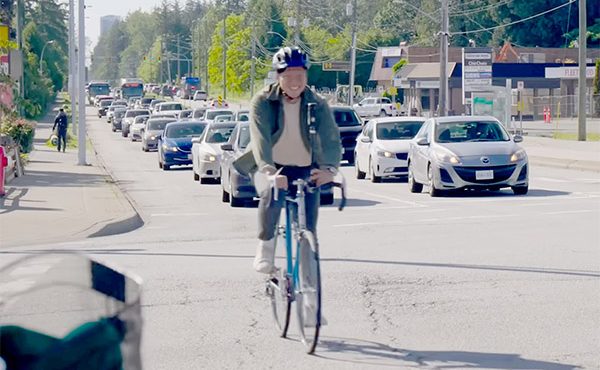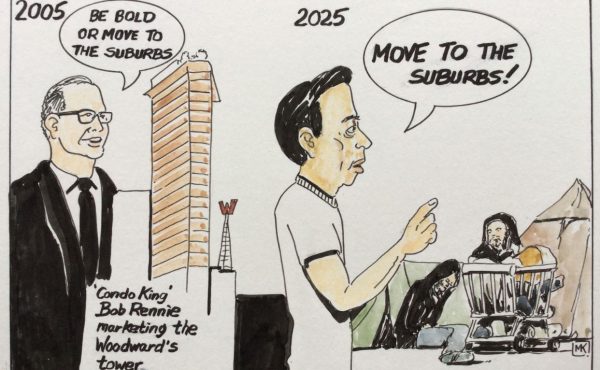
In 1975, the Bureau of Transit Services prepared a transit service plan for downtown Vancouver. Now that 35 years have passed, it’s time to look at what actually got built.
By John Calimente, re:place magazine
It’s always fun to look back at what previous generations were planning for our city. Some plans, like the numerous freeway proposals for the downtown core, haven’t become reality. Others, like Harland Bartholomew’s city plan of 1928, have made a big impact on our city even if they weren’t formally adopted.
The formal title of the 1975 plan was “Draft Memorandum on Transit Service Planning to Complement Downtown Peninsula Plans of the City of Vancouver.” It was created by the BC Government’s Bureau of Transit Services, which was under the Minister of Municipal Affairs, and it was presented to Vancouver City Council on September 23, 1975. The summary statement explains that the memorandum outlines how transit service planning fit in with the City Council’s plans for the downtown peninsula. The summary is followed by 5 chapters: ‘Transit in Downtown Vancouver’, ‘Demand’, ‘Route Layouts in Downtown Vancouver’, ‘Infrastructure and Stations’, and ‘Implementation.
Even 35 years ago it was noted that Vancouver “…doesn’t have sufficient passenger capacity to carry all those persons waiting for our buses. This means we often pass people by or crowd people on board our buses, and we are very sure that neither of these situations would be tolerated by Members of City Council as would-be transit riders.”
The inefficiencies of the automobile were also obvious by 1975. Among the objectives for transit was to “…remove the pressure to build more highways, parking facilities, and bridges” by enabling more people to travel over the existing street network. Automobiles were creating too much traffic, making bus service unreliable and transfers difficult. With Vancouver’s transit system consisting entirely of buses, layovers downtown were a problem. The reports states that “we have problems in finding enough available curb space to park our vehicles while awaiting their return trip time.”

Downtown Activity Areas
The report lists 11 “character areas” within Downtown Vancouver that were “centres of attraction and (trip) generation.” Easily recognizable today are Chinatown, Gastown, Granville/Hastings retail, Robson East/Georgia East, Robson Strasse/Robson Square, West End Residential, and North Side False Creek. Yaletown had not yet become Yaletown yet, though. It was named “Eastern Slopes”. Coal Harbour, lacking its waterfront portion, was called the “Golden Triangle/Financial District” and had no residential development, only offices and hotels. “Transition Area N” is now the still-evolving Downtown South, while the “Waterfront” area connected all the land along Burrard Inlet between Stanley Park and Gastown.
Regional Demand
With an absence of rapid transit in 1975, buses were the only means of ferrying passengers to downtown from all parts of the region. Granville and Hastings Streets were the main entrances to the downtown core. Hastings was the major conduit of bus traffic to and from the North Shore, Burnaby, Coquitlam, and New Westminster, and Surrey, with 109 buses per hour travelling along it during rush hour. Granville was the connection to Richmond, Delta, Ladner, and Tsawwassen. Regional bus services transported about 5,500 people per hour into Downtown Vancouver from outside the city. During rush hour, 20,000 people per hour entered downtown by transit, representing 45% of the Downtown workforce. Anticipating future job growth (180,000 jobs downtown by the year 2000), rapid transit was needed.
The Burrard Inlet Ferry
It’s hard to imagine now, but there was no water connection between the North Shore and the downtown core in 1975. While ferry service had started as far back as 1900, the last ferry to cross Burrard Inlet ran in 1958. The “Burrard Inlet Ferry” was planned to be implemented by mid-1976, with the CPR Station serving as the southern terminus. Each vessel was anticipated to have a capacity of 400 passengers, transporting 2,400 people per hour in each direction with a crossing time of eight minutes.
The ferry, branded ‘SeaBus’, was eventually launched in June 1977, a year behind schedule. It was the first fully accessible transit service in Greater Vancouver and also the first transit service to allow bicycles on board. TransLink’s fleet is now 100% accessible and cyclists have access to most transit vehicles. SeaBus carries about 17,000 people per day and recently celebrated its 100 millionth passenger.
Commuter Train
Consultants were studying a potential commuter train service into Granville station using the CPR mainline. What’s fascinating is that they were definitely envisioning Waterfront Station as a regional hub in 1975. Referencing an earlier report, the concept was for “The Granville Waterfront Station” to accommodate “passenger service of Canadian Pacific passenger trains, the Cross-Inlet ferries, future commuter trains and light rail transit, and CityBUS, FastBUS and Town and Country BUSes.” The ‘CPR Commuter Train’ was proposed to run on rail rights-of-way during peak hours only, from the CPR Station to Port Moody and Port Coquitlam. Intended to reduce travel times and alleviate congestion on the Barnett/Hastings corridor, initial plans called for two peak-hour trips with a total capacity of 3,000 people to be implemented by late 1976 or early 1977.
Unfortunately, the plan wasn’t realized until 1995, when the West Coast Express began service. (One of the key people involved in the creation of the West Coast Express was interviewed on Paul Hillsdon’s website). The long delay is presumably due to the change in provincial government in December of 1975. With five trains running in morning and evening peak periods, average passenger counts had reached 10,500 per day by 2008. CPR’s passenger rail service sadly ended in 1979, with Via Rail taking over the railway’s passenger operations. Passengers from across Canada now disembark at Pacific Central Station.
Light Rail Transit
This LRT section of the plan bears the least resemblance to what actually got built in the downtown peninsula. The 1975 plan called for a light rail network to be implemented in two phases. The first phase was envisioned as a premetro, combining surface and subway routes. The plan was for the subway section to connect ‘Granville Waterfront Station’ with False Creek, under Cambie Street from Cordova to West Pender, then to the False Creek yards along a corridor now occupied by BC Place Stadium (see map). The line would then continue along the ‘Central Park L.R.T. line’, heading out to Burnaby, New Westminster, and North Surrey.
Of course, rather than an at-grade system, the Expo Line SkyTrain was built above ground along the planned route in 1985. The difference in the downtown portion is that no tunneling was needed – fortuitously, the Dunsmuir tunnel became available to be used instead.
Streetcar
Even more exciting, for a streetcar fan at least, was the second phase, with four at-grade streetcar routes planned. The plan stated that an understanding had been reached with Mayor and Council “…that we could work out where in Downtown Vancouver there could be ‘streetcar’ type operation of light rail services”. The accompanying map shows the proposed routes.
The first line would run along Hastings St, reaching as far as North Burnaby. The second route would follow Hornby St through downtown, run across the CPR Kitsilano Trestle that used to connect downtown to Kitsilano, along the Arbutus Line, then on to Richmond and South Delta. The third route would run along Nelson St from Hornby St to Stanley Park, linking Downtown Vancouver with the West End. The fourth route would be a line connecting the waterfront areas. It would run from Stanley Park to Carrall St, right along the water through what is now Coal Harbour and then along a portion of what is now Cordova St. From Carrall it would run through the old Expo Lands, cross the Kitsilano trestle, and on to the Planetarium.
As we now know, Vancouver did eventually get a rapid transit line to Richmond, but only last year and only as far as Richmond City Hall. The waterfront route has morphed into the Downtown Streetcar Project. With the removal of the Kitsilano Trestle in 1982, routing changed from the north to the south side of False Creek. Rights of way are secured, it is only the matter of funding that keeps it from being built.
In my view, Hastings Street would still see huge benefits from the restoration of streetcar service out to North Burnaby. I’m only guessing, but with all those commuters since 1986 taking SkyTrain to go to Burnaby, Surrey, and New Westminster, Hastings Street lost a huge number of potential customers. Was this a factor in the closing of Woodward’s and the decline of the Downtown Eastside? I think it had to be a contributing factor, especially with the lure of the newly-opened Metrotown in Burnaby along the Expo Line.
I’m curious about the proposed line along Nelson St, though. What would be the point of a routing straight through the heart of the West End, along a street with minimal commercial activity? It is definitely the most direct way to reach the West End from downtown, but why along a residential street rather than on Robson or Davie? It’s a mystery to me. Maybe it was just an idea; as we can see, there is still no transit of any kind along Nelson St.
Bus
Downtown bus improvements were targeted for the spring of 1976 to coordinate with inauguration of ferry service to the North Shore. At the time it was thought that the bus network would not be able to handle increases in transit ridership past 1980. The only major change, again, is the proposal for buses to run along Nelson Street. Granville Waterfront Station was also supposed to serve as the downtown terminus for the bus system. This hasn’t really come to pass – the nexus still seems to be in the vicinity of Robson and Granville.
Cyclists? What are those?
The plan does talk briefly about pedestrianization, noting that the Granville Street Mall is a “good example of the integration of transit and pedestrian facilities.” The ‘pedestrian streets’ were envisioned to be Hastings, Granville, Robson, and for some reason, Cambie Street downtown. As for cyclists, there is not one mention in the whole report. It shows me how far we have come in 35 years that a plan like this today would invariably contain a section on cycling in the city.
The plan concludes that “…there really is not much to be gained in professing support for programmes to get more people to use public transit without commitment to actions to give transit priority use of streets in Downtown Vancouver and in other urban centres in the metropolitan area.” That we still haven’t completed transit service planned in 1975 shows me that transit is still not a high enough priority in the region. But we are improving…slowly.
**
John Calimente is the president of Rail Integrated Developments. He supports great mass transit, cycling, walking, transit integrated developments, and non-automobile urban life. Click here to follow TheTransitFan on Twitter.


